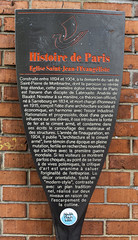Anatole de Baudot
Commemorated on 2 plaques
Église Saint-Jean-l'Évangéliste Construite entre 1894 et 1904 à la demande du curé de Saint-Pierre de Montmartre, dont la paroisse se révèle trop étendue, cette première église moderne de Paris est l’œuvre d'un disciple de Labrouste: Anatole de Baudot. Novateur à sa manière, ce théoricien officiel, né à Sarrebourg en 1834, et mort chargé d'honneurs en 1915, conçoit l’idée d'une architecture sociale et économique, en harmonie avec l'essor industriel. Rationaliste et progressiste, doué d'une grande influence sur ses élèves, il ose introduire la fonte de fer et le ciment armé, et condamne dans ses écrits le camouflage de matériaux et des structures. L’année de l'inauguration, en 1904, il publie "L'architecture et le ciment armé", livre-témoin d'une époque en pleine mutation, fertile en recherches nouvelles, qui s’achève avec la première guerre mondiale. Si les visiteurs se montrent parfois choqués, au point de se livrer à de vives polémiques, la critique d'art est unanime à saluer l’originalité de l’entreprise. Le décor orientaliste, traité en "modern-style", contraste avec un plan traditionnel, réalisé sur deux niveaux en raison de l'escarpement de la colline.
English translation: Église Saint-Jean-l'Évangéliste. Built between 1894 and 1904 at the request of the parish priest of Saint-Pierre de Montmartre, whose parish was too large, this first modern church in Paris is the work of a disciple of Labrouste: Anatole de Baudot. An innovator in his own way, this official theorist, born in Sarrebourg in 1834, and died with honours in 1915, conceived the idea of a social and economic architecture in harmony with industrial growth. Rationalist and progressive, with great influence on his pupils, he dared to introduce iron casting and reinforced cement, and condemned in his writings the camouflage of materials and structures. The year of the inauguration in 1904, he published "L'architecture et le ciment armé", a book-witness of a period in full mutation, fertile in new research, which ends with the First World War. If visitors are sometimes shocked, to the point of engaging in intense polemics, the art critic is unanimous in saluting the originality of the company. The orientalist decor, treated in "modern-style", contrasts with a traditional plan, realised on two levels due to the escarpment of the hill.
Église Saint-Jean-de-Montmartre, 19 Rue des Abbesses, Paris, France where they designed (1894-1904)
Anatole de Baudot 1834-1915
English translation: Baudot Anatole 1834-1915 [AWS Translate]
l'église Saint-Jean-de-Montmartre, Paris, France where they designed

